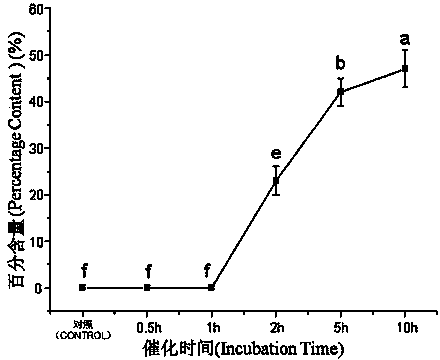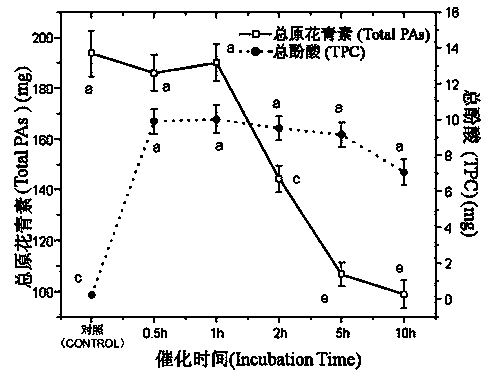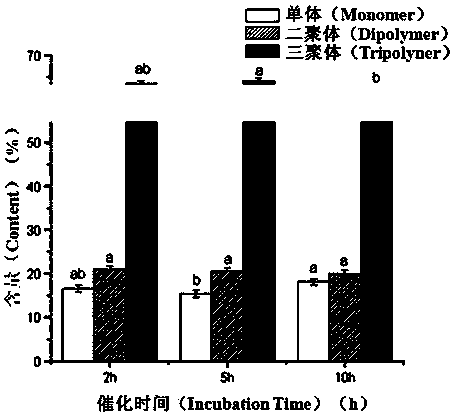Enzyme method for accelerating red wine aging
A red wine and enzymatic technology, applied in the field of red wine aging, can solve the problems of polyphenol oxidative enzymatic browning cannot be completed normally, and achieve the effects of thicker taste, shortened time and better wine color
- Summary
- Abstract
- Description
- Claims
- Application Information
AI Technical Summary
Problems solved by technology
Method used
Image
Examples
Embodiment 1
[0019] Select fresh grapes, remove the stems, clean and crush them, then transfer them to the grape steeping barrel, add 0.02g / L β-glucanase and 0.02g / L pectinase to the steeping barrel, and soak at 25°C for 4 Day, to fully dissolve the pigments and sugars in the grapes, and also to prevent the problem of stratification or excessive precipitation during the maceration process. After maceration, transfer grapes and maceration solution to oak barrels, cover and continue fermentation for 30 days, and stop fermentation when most of the sugar in the fermenter is converted into alcohol. The pomace is removed by filtration to obtain the primary new wine, which is transferred to a corked container. Vacuum deoxygenation of containers containing new wine can be accomplished by vacuuming equipment. Put the semipermeable membrane bag containing apple polyphenol oxidase (dissolved in PBS (2mmol / L) with pH 7.0) into the deoxygenated container containing primary new wine. The amount of pol...
Embodiment 2
[0021] Take low-age red wine available on the market and put it in a glass container with a stopper. The glass container was evacuated and then filled with nitrogen to reduce the oxygen in the glass container. Put the lotus polyphenol oxidase prepared in advance into a semi-permeable membrane and dissolve it with PBS (2mmol / L) at pH 7.0. The semi-permeable membrane can be a dialysis bag for experiments, and its molecular weight cut-off is 20kDa. The amount of lotus polyphenol oxidase added was 0.2g / L, the pH of the red wine was adjusted to 7.0 with sodium bicarbonate, and the reaction was carried out at 25°C for 90min. After stirring, after the reaction is completed, the semi-permeable membrane bag is drawn off and the red wine is filtered, and the filter residue is removed to obtain the accelerated aging red wine. After being bottled for two weeks, take it out for drinking, and its taste is very close to that of aged red wine on the market.
Embodiment 3
[0023] The polyphenol oxidase is obtained by extracting and purifying the polyphenol oxidase-producing fermentation bacteria, and fixing it in a semi-permeable membrane bag. The semi-permeable membrane bag is a dialysis bag, and stored at -20°C for use. Take red wine with a wine age of 2 to 3 months that has just completed fermentation, and put it in a wooden barrel with a good airtight cover. Heating to raise the temperature of the red wine to 40°C, remove the oxygen inside the red wine, and then fill the barrel with CO 2 Gas, so that the red wine is isolated from the air. Add purified water into the fixed polyphenol oxidase semi-permeable membrane bag to fully dissolve it. Tighten the dialysis bag, put it into a wooden barrel filled with red wine, cover it, and react. Wherein, the addition amount of bacterial polyphenol oxidase is 0.3g / L, and react at 25°C for 100min. After the reaction is completed, the polyphenol oxidase membrane bag is taken out, and the slag is remove...
PUM
 Login to View More
Login to View More Abstract
Description
Claims
Application Information
 Login to View More
Login to View More - R&D
- Intellectual Property
- Life Sciences
- Materials
- Tech Scout
- Unparalleled Data Quality
- Higher Quality Content
- 60% Fewer Hallucinations
Browse by: Latest US Patents, China's latest patents, Technical Efficacy Thesaurus, Application Domain, Technology Topic, Popular Technical Reports.
© 2025 PatSnap. All rights reserved.Legal|Privacy policy|Modern Slavery Act Transparency Statement|Sitemap|About US| Contact US: help@patsnap.com



